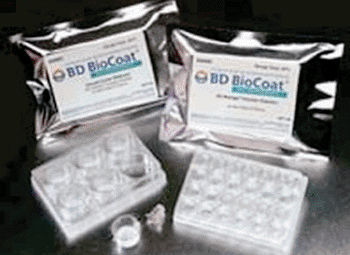Biomarker Improves Diagnosis of Esophageal Cancer
By LabMedica International staff writers
Posted on 23 Jan 2014
A biomarker has been discovered that has the potential to improve the diagnosis, prognosis, and treatment of Esophageal Squamous Cell Carcinoma (ESCC), the major histological form of esophageal cancer, a leading cause of cancer death worldwide. Posted on 23 Jan 2014
Currently, there is poor prognosis for ESCC patients and the five-year overall survival rate ranges from 20% to 30%, and as such, there is an urgent need for biomarkers which can diagnose this disease as early as possible to estimate reaction to chemotherapy or radiotherapy in patients and predict the overall survival rate of patients undergoing treatment.

Image: BioCoat Matrigel Invasion Chambers (Photo courtesy of BD Bioscience).
Scientists at the National University of Singapore (Singapore) studied between 2010–2011 a total of 69 paired primary ESCC tumor tissues and their matched nontumorous tissues that were surgically removed, snap-frozen in liquid nitrogen for protein, ribonucleic acid (RNA), and DNA extraction. The study included a second cohort of a total of 180 paired primary ESCC tumor tissues and their matched non-tumor tissues that were surgically removed and embedded in a paraffin block for tissue microarray (TMA) construction between 2001 and 2005.
The investigators discovered that the RNA editing enzyme adenosine deaminase acting on RNA-1 (ADAR1), which catalyzes the editing process, is significantly overexpressed in ESCC tumors. They observed that the ADAR1 changes the product of the Antizyme Inhibitor 1 (AZIN1) protein to a form that promotes the development of the disease. Clinically, the tumoral overexpression of ADAR1 gene was correlated with the shorter survival time of ESCC patients. RNA editing was analyzed by real-time polymerase chain reaction and migration invasion assays were performed using 24-well BioCoat Matrigel Invasion Chambers (BD Biosciences; San Jose, CA, USA).
Leilei Chen, MD, PhD, a senior author of the study said, “Investigating the connection between ADAR1-mediated RNA editing and cancer progression is only the initial step in this investigation. The tumoral over-expression of ADAR1 can be used as an early warning sign of ESCC and halting or reversing the process may block the cells' conversion from normal to malignant.” The authors concluded that that ADAR1 can serve as a useful biomarker to detect disorders leading to ESCC and as a potential therapeutic target. The study may also provide the key to a biological process for drug development in the treatment of ESCC. The study was published on December 3, 2013, in the journal Cancer Research.
Related Links:
National University of Singapore
BD Biosciences













.jpg)